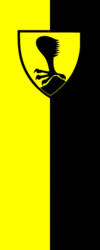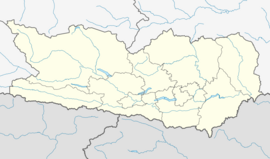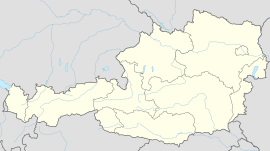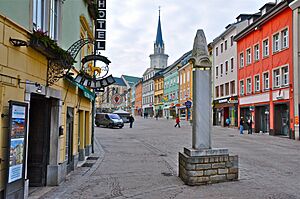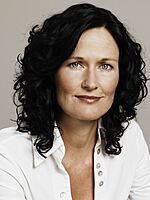Villach facts for kids
Quick facts for kids
Villach
|
|||
|---|---|---|---|
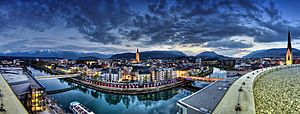
Drava riverside
|
|||
|
|||

Location of Villach within Carinthia
|
|||
| Country | |||
| State | |||
| District | Statutory city | ||
| Area | |||
| • Total | 134.98 km2 (52.12 sq mi) | ||
| Elevation | 501 m (1,644 ft) | ||
| Time zone | UTC+1 (CET) | ||
| • Summer (DST) | UTC+2 (CEST) | ||
| Postal code |
9500
|
||
| Area code | 04242 | ||
| Vehicle registration | VI | ||
| Website | villach.at | ||
Villach (pronounced FIL-akh) is the seventh-largest city in Austria. It's the second-largest city in the state of Carinthia. Villach is a very important traffic hub for southern Austria and the wider Alpe-Adria region. As of 2018, about 61,887 people live there.
Villach is part of the Alpine Town of the Year Association. This group works to make sure cities in the Alps grow in a way that is good for the environment and people. In 1997, Villach was the first city to be named "Alpine Town of the Year."
Contents
Geography and Location
Villach is a special kind of city in Austria called a statutory city. It sits on the Drau River, close to where the Gail River joins it. The city is on the western edge of the Klagenfurt basin.
The city area stretches from the mountains of the Gailtal Alps (like Mount Dobratsch) all the way to Lake Ossiach in the northeast. Villach includes many different districts and villages. Some of these areas have been added to the city over time, like St. Martin in 1905 and Landskron, Maria Gail, and Fellach in 1973.
Villach's Climate
Villach has a cool summer humid continental climate. This means it has warm summers and cold winters, with rainfall spread throughout the year.
| Climate data for Villach 1971-2000 | |||||||||||||
|---|---|---|---|---|---|---|---|---|---|---|---|---|---|
| Month | Jan | Feb | Mar | Apr | May | Jun | Jul | Aug | Sep | Oct | Nov | Dec | Year |
| Mean daily maximum °C (°F) | 1.4 (34.5) |
5.2 (41.4) |
10.6 (51.1) |
14.9 (58.8) |
20.2 (68.4) |
23.4 (74.1) |
25.6 (78.1) |
25.2 (77.4) |
20.8 (69.4) |
14.5 (58.1) |
6.6 (43.9) |
1.8 (35.2) |
14.2 (57.6) |
| Daily mean °C (°F) | −3.2 (26.2) |
−0.6 (30.9) |
4.0 (39.2) |
8.3 (46.9) |
13.5 (56.3) |
16.7 (62.1) |
18.7 (65.7) |
18.3 (64.9) |
14.1 (57.4) |
8.5 (47.3) |
2.2 (36.0) |
−2.1 (28.2) |
8.2 (46.8) |
| Mean daily minimum °C (°F) | −6.4 (20.5) |
−4.6 (23.7) |
−0.8 (30.6) |
3.1 (37.6) |
7.9 (46.2) |
11.1 (52.0) |
12.9 (55.2) |
12.8 (55.0) |
9.2 (48.6) |
4.6 (40.3) |
−0.7 (30.7) |
−4.8 (23.4) |
3.7 (38.7) |
| Average precipitation mm (inches) | 46.8 (1.84) |
47.1 (1.85) |
65.5 (2.58) |
83.2 (3.28) |
96.1 (3.78) |
120.5 (4.74) |
133.7 (5.26) |
111.3 (4.38) |
102.3 (4.03) |
105.5 (4.15) |
102.2 (4.02) |
61.2 (2.41) |
1,075.4 (42.34) |
| Average precipitation days (≥ 1.0 mm) | 5.9 | 5.3 | 7.1 | 9.0 | 10.4 | 12.0 | 11.9 | 10.1 | 8.2 | 8.3 | 7.7 | 6.3 | 102.2 |
| Mean monthly sunshine hours | 84.4 | 120.3 | 160.6 | 167.7 | 208.4 | 214.3 | 245.2 | 227.2 | 190.3 | 142.0 | 85.9 | 73.2 | 1,919.5 |
| Source: Zamg.ac.at | |||||||||||||
History of Villach
People have lived in the Villach area since the late Neolithic period (Stone Age). Many Roman objects have been found here because it was close to an important Roman road. This road led from Italy to the Roman province of Noricum. There was likely a resting stop called Sanctium near a hot spring in what is now the Warmbad area.
After the Migration Period (around 600 AD), Slavic people settled here, and the area became part of the Carantania principality. Later, in 878, a document mentioned a bridge in Villach. In 1007, the settlement was given to the Prince-Bishopric of Bamberg, a powerful church area. Villach remained under their control until 1759.
Villach gained the right to hold a market in 1060. It was first called a "town" around 1240. The church of St. James was first mentioned in 1136. In 1222, the town was given permission to hold an annual fair. Villach faced challenges over the centuries, including big earthquakes in 1348 and 1690, and several fires that destroyed buildings.
In the 1500s, many people in Villach became Protestant. This led to difficulties with the church rulers, and many residents were forced to leave the town, which caused the economy to slow down. In 1759, the Habsburg empress Maria Theresa bought the Bamberg lands in Carinthia, and Villach became part of the Austrian Empire.
During the Napoleonic Wars, French troops took over Villach for a short time. But in 1813, Austrian forces took it back. A big boost for the city's economy came in 1864 when the Southern Railway line reached Villach. This helped the city grow and expand. By 1880, Villach had a population of 6,104 people.
In World War I, Villach was close to the Italian front and served as a military command center. On January 1, 1932, Villach officially became a statutory city. After Austria became part of Nazi Germany in 1938, the mayor of Villach was Oskar Kraus, who was a strong supporter of the Nazi Party. During this time, there were attacks on the Jewish population in Villach, as happened in many places across Germany and Austria.
During World War II, Villach was bombed 37 times by Allied forces. About 300 people died, and 85% of the buildings were damaged. However, the city recovered quickly after the war. Today, Villach is a busy city with lots of businesses and fun activities, while still keeping its rich history.
Population Growth
Villach's population has grown steadily over the years. Here's how it has changed:
| Historical population | ||
|---|---|---|
| Year | Pop. | ±% |
| 1910 | 27,451 | — |
| 1923 | 30,883 | +12.5% |
| 1934 | 34,085 | +10.4% |
| 1939 | 36,012 | +5.7% |
| 1951 | 43,358 | +20.4% |
| 1961 | 47,170 | +8.8% |
| 1971 | 51,112 | +8.4% |
| 1981 | 52,692 | +3.1% |
| 1991 | 54,640 | +3.7% |
| 2001 | 57,497 | +5.2% |
| 2011 | 59,285 | +3.1% |
| 2016 | 61,221 | +3.3% |
Sister Cities
Villach has special connections with other cities around the world, called "twin towns" or "sister cities." These connections help promote cultural exchange and friendship. Villach is twinned with:
Festivals and Events
Villach hosts several fun festivals throughout the year:
- The carnival in Villach starts on November 11 and ends on March 4.
- The arts and crafts festival features handmade goods.
- Villacher Fasching is a big Mardi Gras celebration.
- The streets-art festival showcases performances by artists and singers.
- The "Villacher Kirchtag" is a week-long summer festival that ends on the first Saturday of August.
- You can also enjoy performances on a special floating stage on the Drau River.
Notable People from Villach
Many interesting people have come from Villach or lived there. Here are a few:
- Oskar Potiorek (1853 – 1933): An Austro-Hungarian Army officer who was the Governor of Bosnia and Herzegovina.
- Paul Watzlawick (1921 – 2007): An Austrian-American therapist and psychologist known for his work on communication.
- Peter Brabeck-Letmathe (born 1944): A successful businessman who was the former CEO of the Nestlé Group.
- Eva Glawischnig-Piesczek (born 1969): An Austrian politician.
- Anna Gasser (born 1991): A famous snowboarder and two-time Olympic gold medalist in Big Air.
- Marco Schwarz (born 1995): An Austrian World Cup alpine ski racer.
Sports Figures
Villach has also produced many talented athletes:
- Ernst Melchior (1920 – 1978): An Austrian football player who played many games for Austria Wien and the Austrian national team.
- Christian Mayer (born 1972): A former alpine skier who won two bronze medals at the Winter Olympics.
- Martin Koch (born 1982): A former ski jumper who won a team gold medal at the 2006 Winter Olympics.
- Michael Grabner (born 1987): An Austrian professional ice hockey player who has played in the NHL.
- Michael Raffl (born 1988): Another professional ice hockey player from Villach who plays in the NHL.
- Guido Burgstaller (born 1989): A footballer who plays for Rapid Wien and has played for the Austrian national team.
- Daniela Ulbing (born 1998): An Austrian snowboarder who won a silver medal at the 2022 Winter Olympics.
Images for kids
See also
 In Spanish: Villach para niños
In Spanish: Villach para niños


